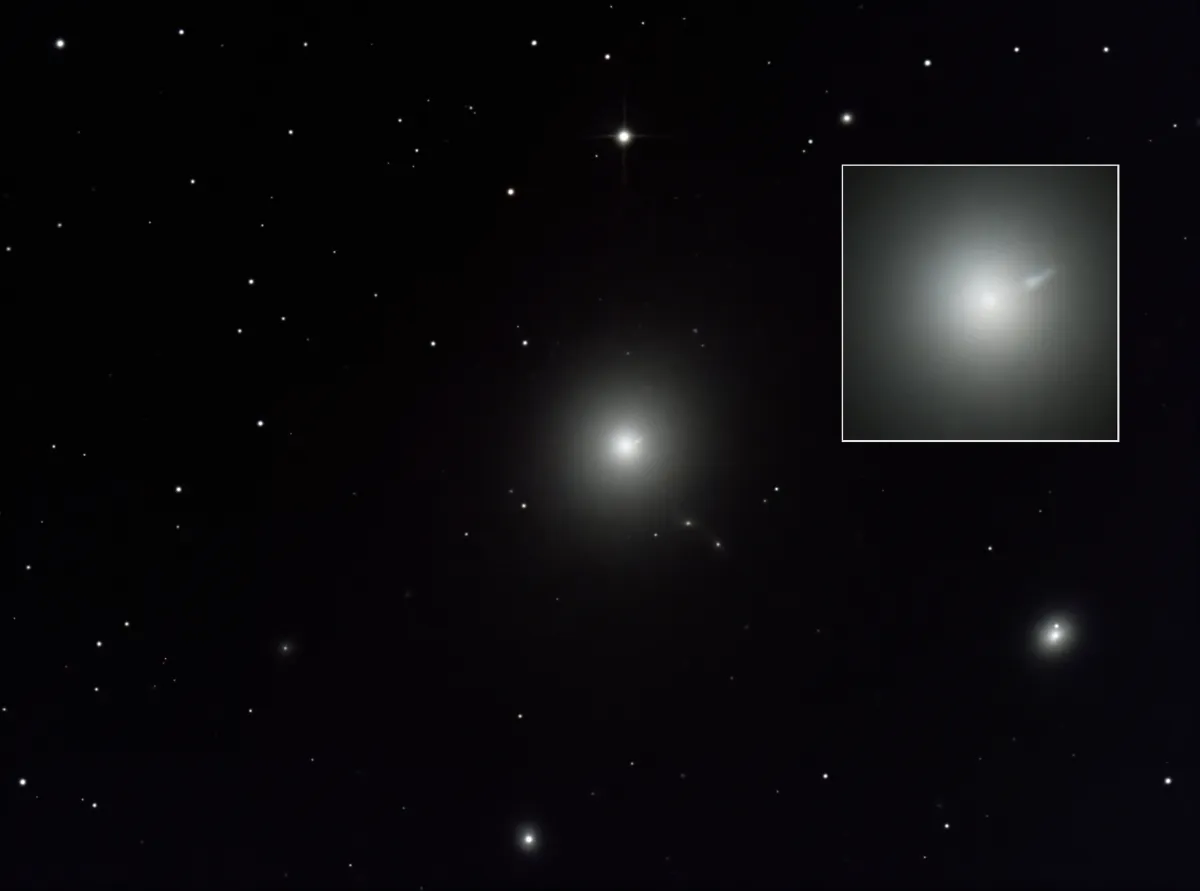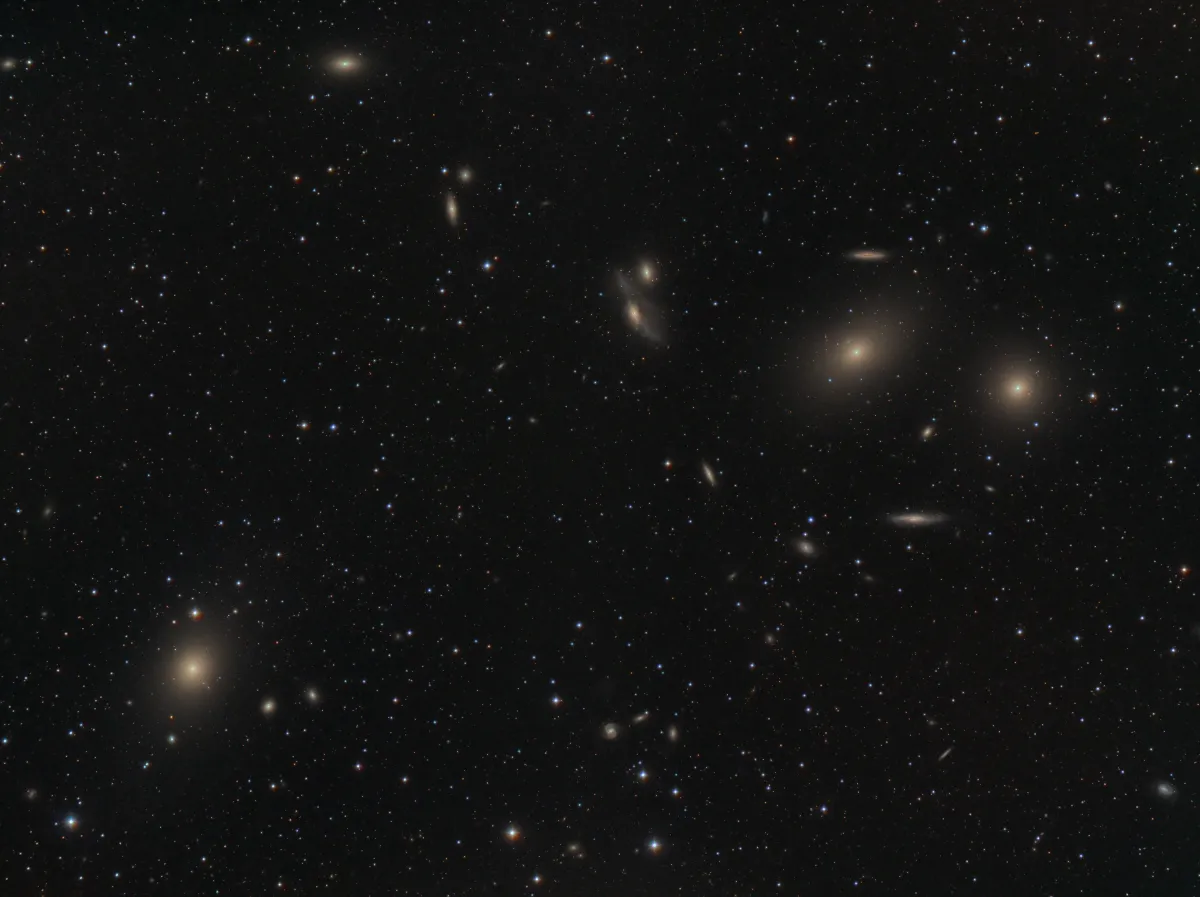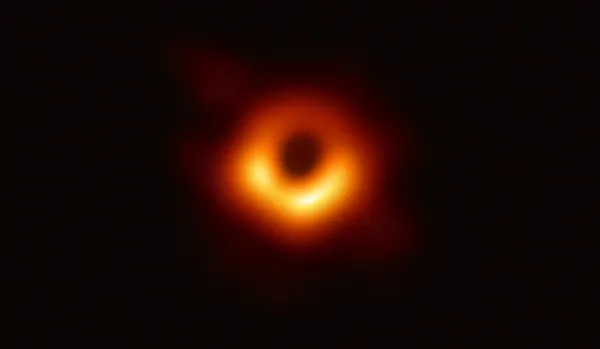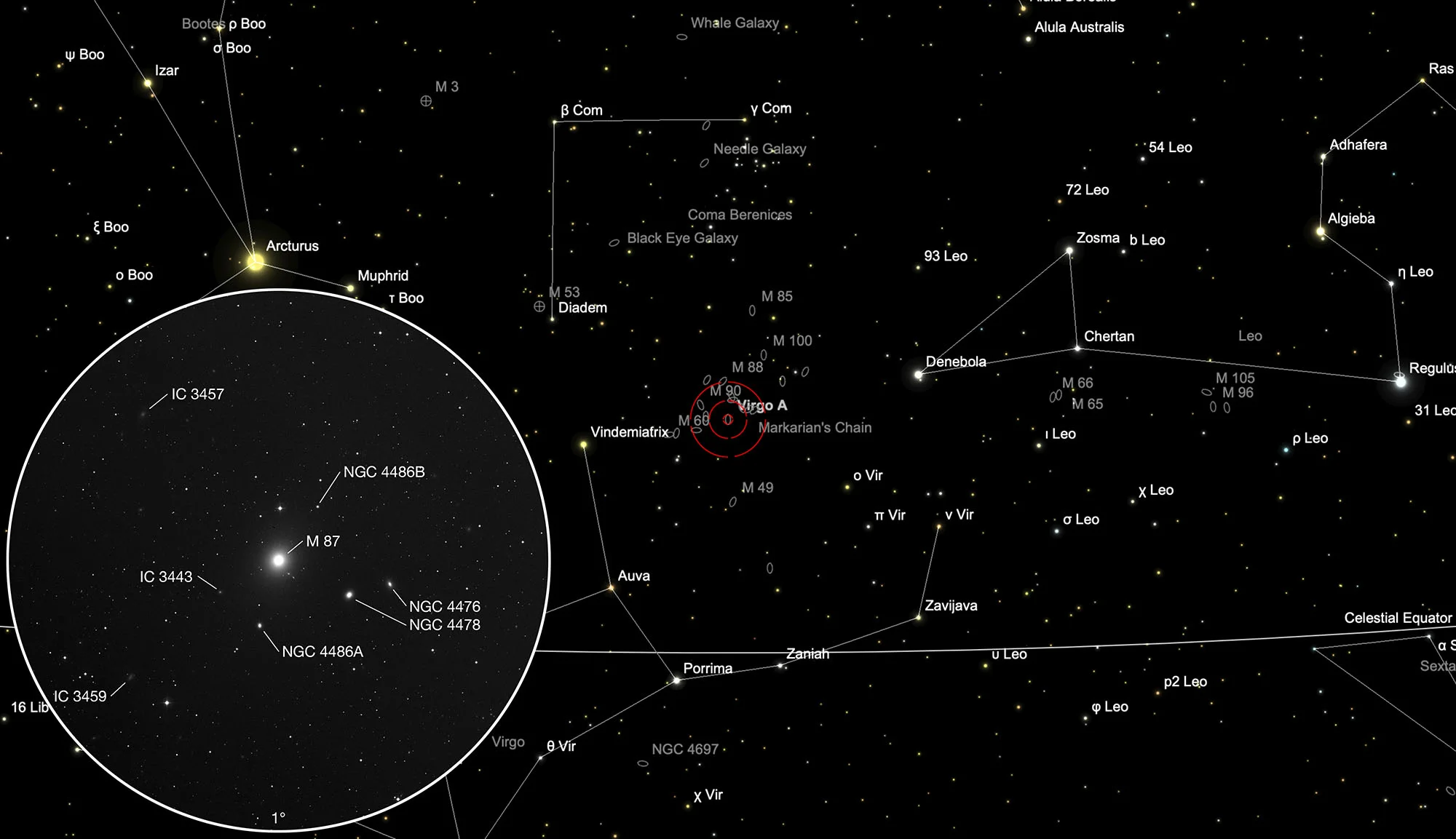Virgo A (Messier 87)

History
The galaxy M 87 was discovered on 5 May 1779 by the German astronomer Johann Köhler. Charles Messier sighted them on 18 March 1781 and wrote: «Nebula without a star in Virgo, below and right next to an 8th magnitude star. The star has the same right ascension as the nebula [...] This nebula has the same brightness as nos. 84 and 86.» [196, 281]
In 1918, a strange straight beam 20 arc seconds long and 2 arc seconds wide was discovered in M 87, which appeared to come from the bright core of the galaxy and was much bluer than the rest of the galaxy. In 1947 a strong radio source was discovered in the constellation Virgo and named «Virgo A». The measured position showed a correspondence with M 87. In 1953 it could be proven that the source of this radio emission was the blue jet from M 87. In the «Third Cambridge Catalog of Radio Sources» published in 1959, it has the designation 3C 274 and is the fifth most powerful radio source in the sky. In 1966 it was also discovered that M 87 and the jet were a powerful source of X-rays, the energy of which was about ten times that in the optical and radio realms. [4, 288, 289]


Physical Properties

The elliptical galaxy M 87 is 55 million light years away from us and is home to several trillion (1012) stars, a supermassive black hole of about 6.5 billion solar masses and about 15,000 globular clusters. For comparison, our Milky Way contains a few hundred billion stars and around 150 globular clusters. The monstrous galaxy M 87 is the dominant member of the neighboring Virgo galaxy cluster, which contains around 2000 galaxies.
Fig. 1 is a composite image of images in visible light and in the infrared and shows the most impressive feature of this galaxy: a jet consisting of relativistically accelerated matter originating from the central supermassive black hole in the core of M 87. In 2019, researchers succeeded thanks to the interconnection of eight radio telescopes distributed around the globe to take a photo of a black hole for the first time. Petabytes of data were processed in a supercomputer for this purpose. (Fig. 4) [215, 287]
| Name | RA | Dec | Type | bMag | vMag | B-V | SB | Dim | PA | z | D(z) | MD | Dreyer Description | Identification, Remarks |
|---|---|---|---|---|---|---|---|---|---|---|---|---|---|---|
| NGC 4476 | 12 29 59.0 | +12 20 55 | Gx (E-S0) | 13.0 | 12.2 | 0.8 | 12.8 | 1.8 × 1.3 | 25 | 0.006571 | 27.76 | 16.280 | F, S, R, bM, 1st of 3 | WH II 123; h 1296; GC 3028; UGC 7637; MCG 2-32-96; CGCG 70-128; VCC 1250; IRAS 12274+1237 |
| NGC 4478 | 12 30 17.3 | +12 19 43 | Gx (E2) | 12.4 | 11.5 | 0.9 | 12.7 | 1.8 × 1.5 | 140 | 0.004500 | 19.01 | 15.900 | pB, S, R, psbM, 2nd of 3 | WH II 124; h 1298; GC 3031; UGC 7645; MCG 2-32-99; CGCG 70-133; VCC 1279 |
| NGC 4486 | 12 30 49.4 | +12 23 26 | Gx (E2/P) | 9.6 | 8.6 | 1.0 | 13.0 | 8.3 × 6.6 | 170 | 0.004360 | 18.42 | 16.840 | vB, vL, R, mbM, 3rd of 3 | h 1301; GC 3035; M 87; UGC 7654; MCG 2-32-105; CGCG 70-139; Arp 152; VCC 1316; IRAS 12282+1240; 3C 274; Virgo A |
| NGC 4486 A | 12 30 57.7 | +12 16 16 | Gx (E2) | 13.5 | 12.5 | 1.0 | 11.9 | 0.8 × 0.7 | 4 | 0.000500 | 2.11 | 16.650 | vB, vL, R, mbM, 3rd of 3 | h 1301; GC 3035; UGC 7658; MCG 2-32-110; CGCG 70-141; ARAK 372; VCC 1327 |
| NGC 4486 B | 12 30 32.0 | +12 29 26 | Gx (E0) | 14.4 | 13.4 | 1.0 | 12.2 | 0.6 × 0.6 | 0.005187 | 21.91 | 15.070 | vB, vL, R, mbM, 3rd of 3 | h 1301; GC 3035; MCG 2-32-101; UGCA 283; 1ZW 38; VCC 1297 | |
| IC 3443 | 12 31 15.6 | +12 19 56 | Gx (E-S0) | 15.8 | 14.9 | 0.9 | 13.0 | 0.4 × 0.4 | 0.006565 | 27.73 | bM, magn 15.5 | MCG 2-32-112; CGCG 70-143; VCC 1348; NPM1G +12.0322 | ||
| IC 3457 | 12 31 51.4 | +12 39 26 | Gx (E3) | 14.7 | 13.9 | 0.8 | 13.5 | 1.2 × 0.8 | 135 | 0.004326 | 18.27 | S, R, lbM | UGC 7672; MCG 2-32-114; CGCG 70-146; VCC 1386 | |
| IC 3459 | 12 31 55.9 | +12 10 29 | Gx (Im) | 14.8 | 14.2 | 0.6 | 13.9 | 1.1 × 0.8 | 155 | 0.000927 | 3.92 | vF, pS, dif | UGC 7674; MCG 2-32-115; CGCG 70-147; VCC 1392 |
Finder Chart
M 87 is located in the constellation Virgo on the line of the two stars Vindemiatrix (ε Virginis) and Denebola (β Leonis). The outermost Telrad circle is in the middle of the two stars. M 87 is to the east of it.
Visual Observation

762 mm aperture: Using EAA (Electronically Assisted Astronomy): The jet in the Messier 87 galaxy could only be seen on a Canon EOS R by means of strong zooming in the live photo. Seldom have we been able to experience such good transparency and calmness. — 1. 6. 2019, Eduard von Bergen
